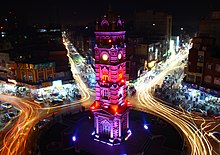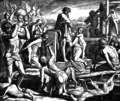The Cities Portal

A city is a human settlement of a notable size. The term "city" has different meanings around the world and in some places the settlement can be very small. Even where the term is limited to larger settlements, there is no universally agreed definition of the lower boundary for their size. In a more narrow sense, a city can be defined as a permanent and densely settled place with administratively defined boundaries whose members work primarily on non-agricultural tasks. Cities generally have extensive systems for housing, transportation, sanitation, utilities, land use, production of goods, and communication. Their density facilitates interaction between people, government organizations, and businesses, sometimes benefiting different parties in the process, such as improving the efficiency of goods and service distribution.
Historically, city dwellers have been a small proportion of humanity overall, but following two centuries of unprecedented and rapid urbanization, more than half of the world population now lives in cities, which has had profound consequences for global sustainability. Present-day cities usually form the core of larger metropolitan areas and urban areas—creating numerous commuters traveling toward city centres for employment, entertainment, and education. However, in a world of intensifying globalization, all cities are to varying degrees also connected globally beyond these regions. This increased influence means that cities also have significant influences on global issues, such as sustainable development, climate change, and global health. Because of these major influences on global issues, the international community has prioritized investment in sustainable cities through Sustainable Development Goal 11. Due to the efficiency of transportation and the smaller land consumption, dense cities hold the potential to have a smaller ecological footprint per inhabitant than more sparsely populated areas. Therefore, compact cities are often referred to as a crucial element in fighting climate change. However, this concentration can also have significant negative consequences, such as forming urban heat islands, concentrating pollution, and stressing water supplies and other resources. (Full article...)
Selected city -
Cairo (/ˈkaɪroʊ/ ⓘ KY-roh; Arabic: القاهرة, romanized: al-Qāhirah) is the capital of Egypt and the city-state Cairo Governorate, and is the country's largest city, home to 10 million people. It is also part of the largest urban agglomeration in Africa, the Arab world and the Middle East: The Greater Cairo metropolitan area is the 12th-largest in the world by population with a population of over 22.1 million.
Cairo is associated with ancient Egypt, as the Giza pyramid complex and the ancient cities of Memphis and Heliopolis are located in its geographical area. Located near the Nile Delta, the city first developed as Fustat following the Muslim conquest of Egypt in 641 next to an existing ancient Roman fortress, Babylon. Cairo was founded by the Fatimid dynasty in 969. It later superseded Fustat as the main urban centre during the Ayyubid and Mamluk periods (12th–16th centuries). Cairo has long been a centre of the region's political and cultural life, and is titled "the city of a thousand minarets" for its preponderance of Islamic architecture. Cairo's historic center was awarded World Heritage Site status in 1979. Cairo is considered a World City with a "Beta +" classification according to GaWC. (Full article...)Did you know -
- ... that the Neil Simon Theatre, a New York City landmark, was the first Broadway theater renamed after a living playwright?
- ... that two days after it had ignited, the Tiger Fire had already burned 5,567 acres (2,253 ha) of land near Black Canyon City, Arizona?
- ... that in the early 20th century, "playing the Palace" was said to mark the pinnacle of a vaudeville entertainer's career?
- ... that early in her career, Maria Calegari danced principal roles in every ballet performed one weekend by the New York City Ballet?
- ... that the Sherwood Studio Building was characterized in 1892 as New York City's "uptown headquarters of Art", with many of its tenants having studied art together?
- ... that before Foster City was built on Brewer Island, unsuccessful proposals included a hog farm, two military air bases, two civilian airports, and an entertainment complex larger than Disneyland?
Related portals
Related WikiProjects

Faisalabad ( /fɑːɪsɑːlˌbɑːd/; Punjabi, Urdu: فیصل آباد, Punjabi pronunciation: [fɛːsə̆ləˌbäːd]; Urdu pronunciation: [fɛːsˈlɑˌbɑːd] ⓘ), formerly known as Lyallpur (Punjabi, Urdu: لائل پور), is the second largest city and industrial centre of the Pakistani province of Punjab. It is a metropolitan city of Pakistan and the third largest and populous city in Pakistan, with an estimated population of 3.7 million in 2023 with the growth rate of 2.37%. It is situated in the north-east of the country, lying between the plains of the Ravi and Chenab River. Faisalabad is one of Pakistan's wealthiest and most industrialized city, the largest industrial hub and second largest city of the wider Punjab region.
Historically one of the largest villages of Punjab, Lyallpur was one of the first planned cities within British India, it has long since developed into a cosmopolitan metropolis. Faisalabad was restructured into city district status; a devolution promulgated by the 2001 local government ordinance (LGO). The total area of Faisalabad District is 5,856 km2 (2,261 sq mi) while the area controlled by the Faisalabad Development Authority (FDA) is 1,326 km2 (512 sq mi). (Full article...)Selected article -

The George Floyd protests were a series of police brutality demonstrations and riots that began in Minneapolis in the United States on May 26, 2020. The protests and civil unrest began as part of international reactions to the murder of George Floyd, a 46-year-old African American man, during an arrest. Derek Chauvin, a Minneapolis Police Department officer, knelt on Floyd's neck for 9 minutes and 29 seconds as three other officers looked on and prevented passers-by from intervening. Chauvin and the other three officers involved were later arrested. In April 2021, Chauvin was found guilty of second-degree murder, third-degree murder, and second-degree manslaughter. In June 2021, Chauvin was sentenced to 22+1⁄2 years in prison.
The George Floyd protest movement began hours after his murder as bystander video and word of mouth began to spread. Protests first emerged at the East 38th and Chicago Avenue street intersection in Minneapolis, the location of Floyd's arrest and murder, and other locations in the Minneapolis–Saint Paul metropolitan area of Minnesota. Protests quickly spread nationwide and to over 2,000 cities and towns in over 60 countries in support of the Black Lives Matter (BLM) movement. Polls in the summer of 2020 estimated that between 15 million and 26 million people had participated at some point in the demonstrations in the United States, making the protests the largest in U.S. history. (Full article...)General images -
Topics
List articles
Subcategories
Associated Wikimedia
The following Wikimedia Foundation sister projects provide more on this subject:
-
Commons
Free media repository -
Wikibooks
Free textbooks and manuals -
Wikidata
Free knowledge base -
Wikinews
Free-content news -
Wikiquote
Collection of quotations -
Wikisource
Free-content library -
Wikiversity
Free learning tools -
Wiktionary
Dictionary and thesaurus







































